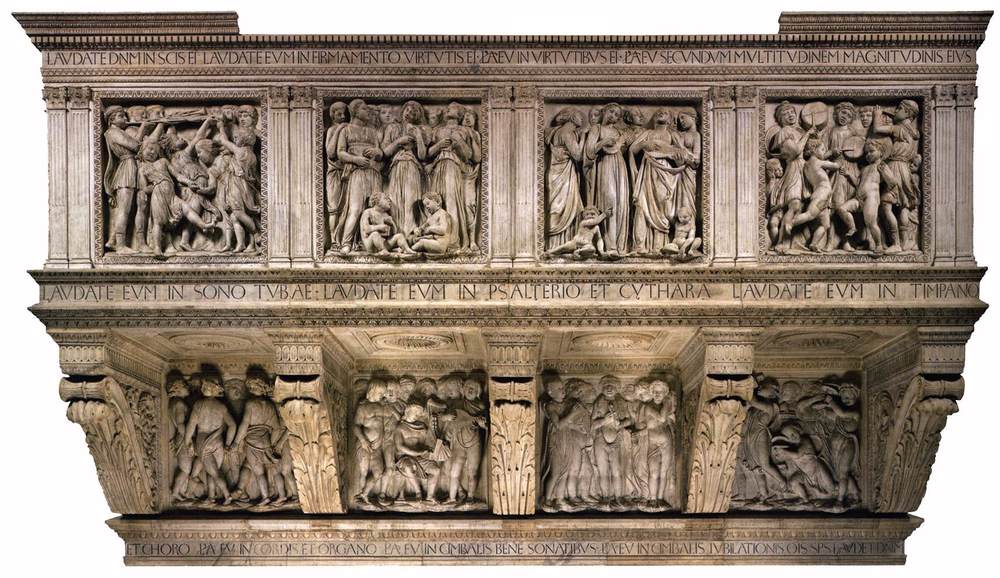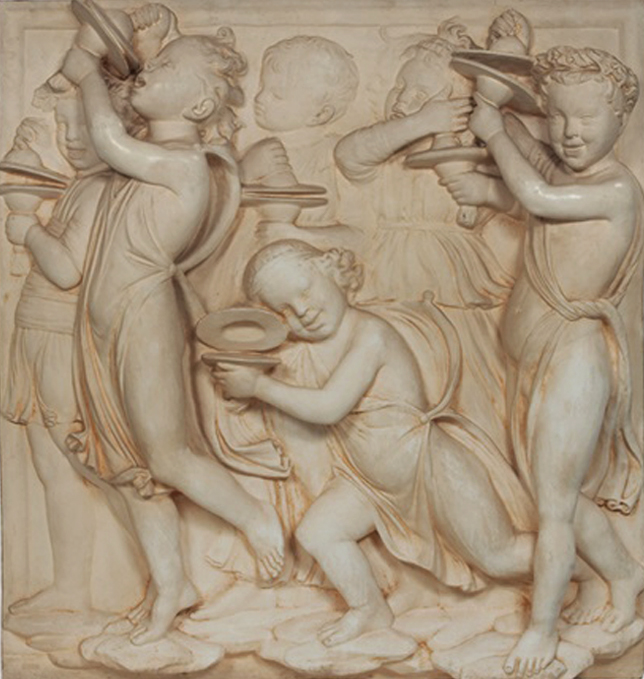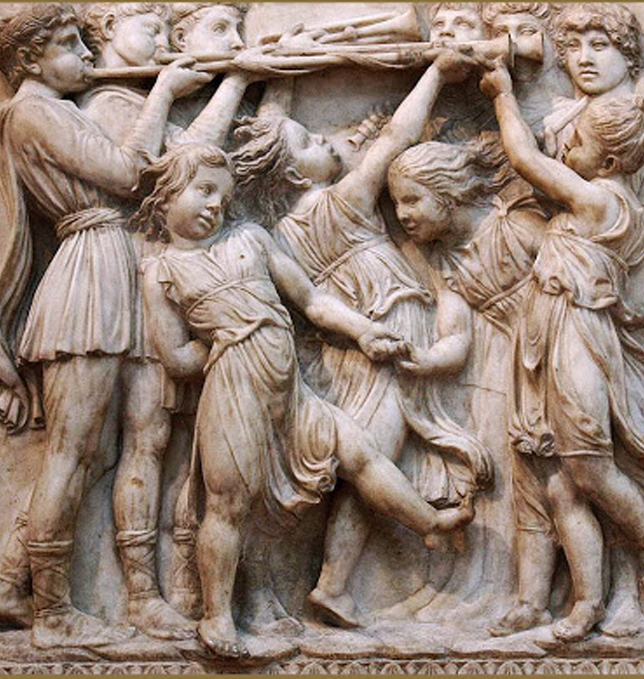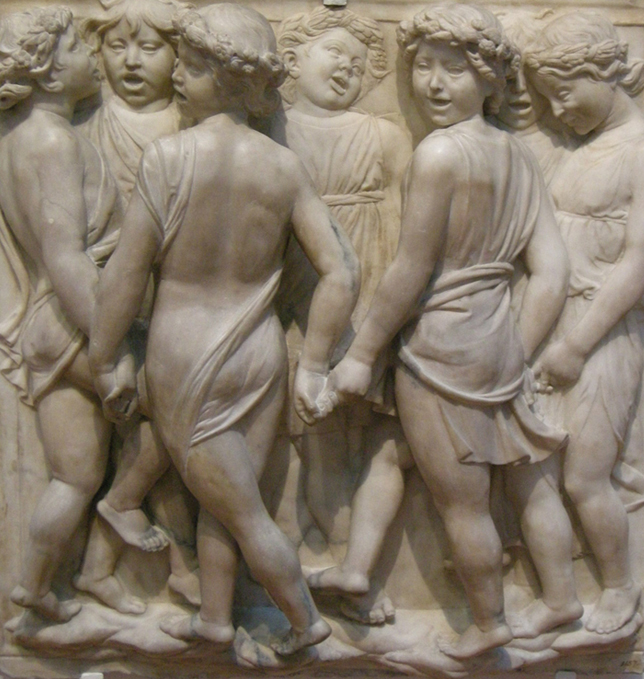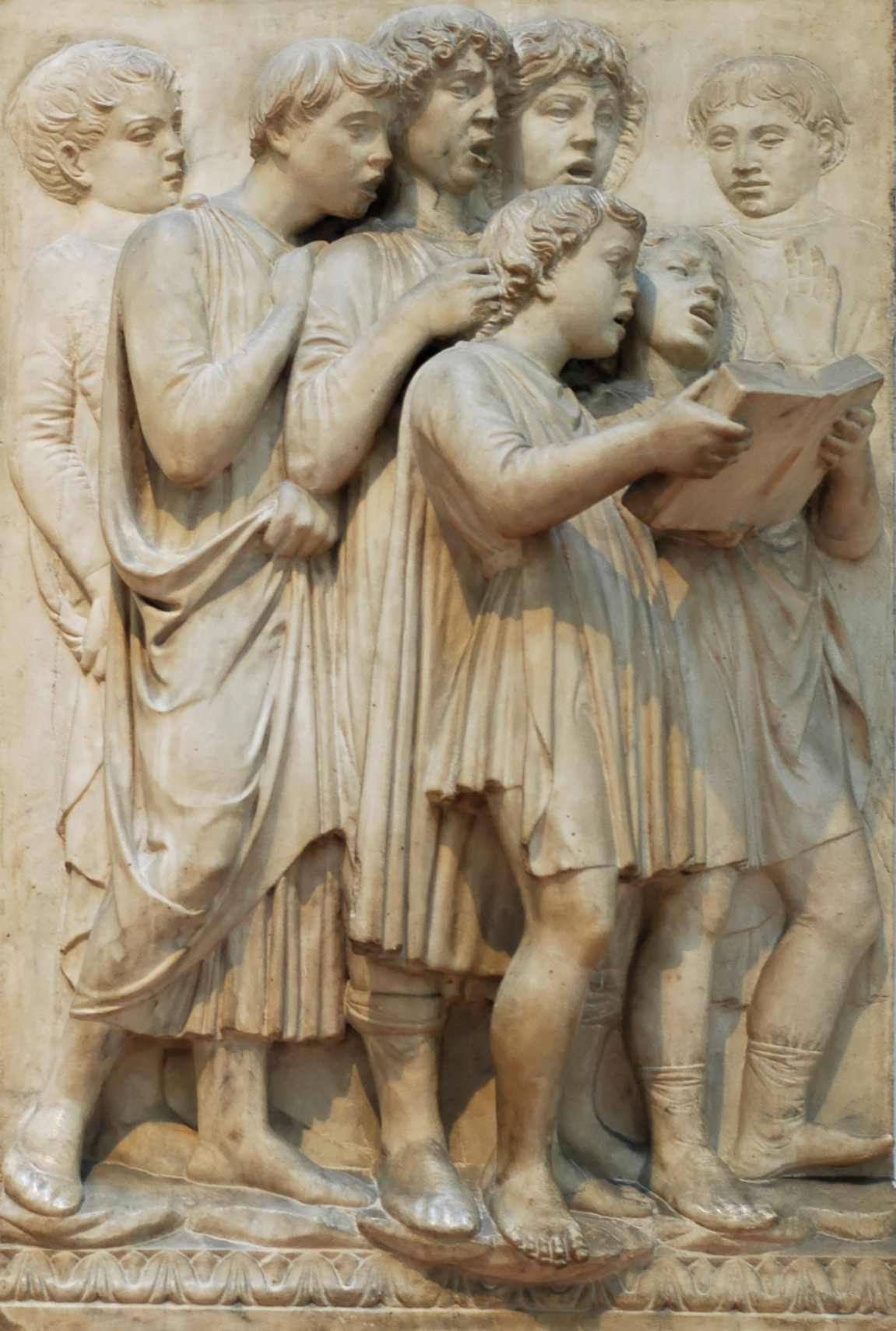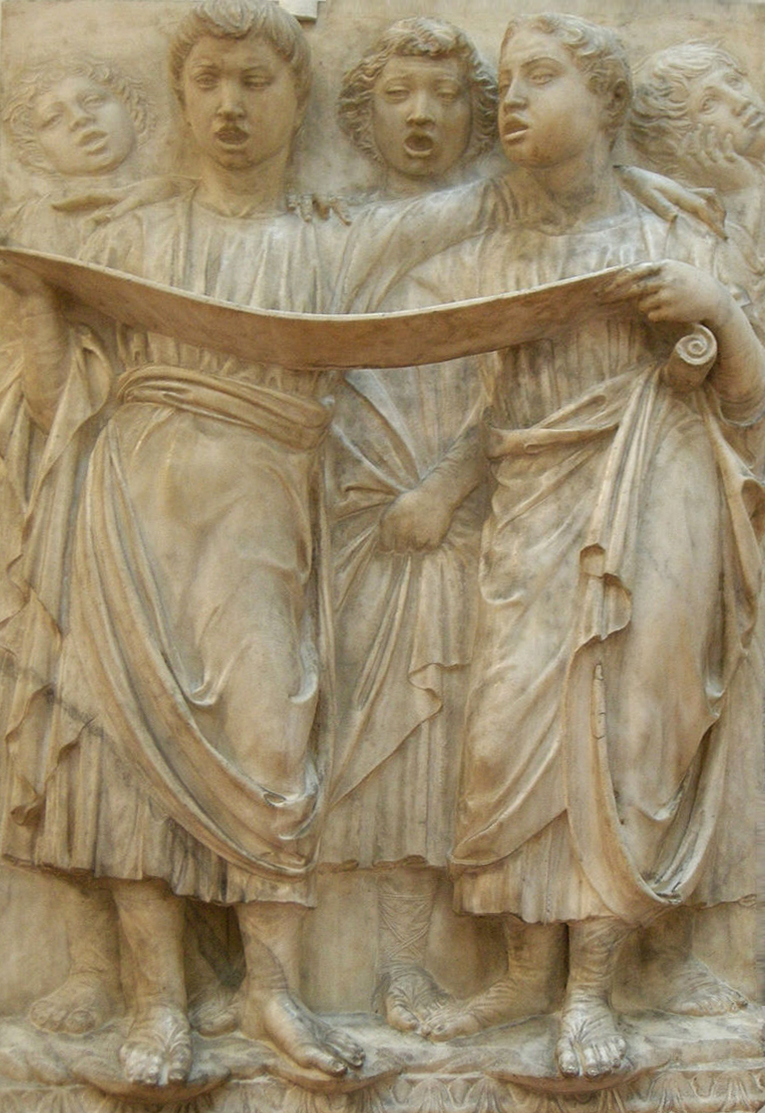December 14: Children Offer Perfect Praise
♫ Music:
Day 13 - Friday, December 14
Children Offer Perfect Praise
Scripture: Matthew 21:15-16
But when the chief priests and the scribes saw the wonderful things that he did, and the children that were crying in the temple and saying, Hosanna to the son of David; they were moved with indignation, and said unto him, Hearest thou what these are saying? And Jesus saith unto them, Yea: did ye never read, Out of the mouth of babes and sucklings thou hast perfected praise?
Poetry:
The Dimensions of the Milky Way
by Marilyn Nelson
Discovered by Harlow Shapley, 1918
Behind the men’s dorm
at dusk on a late May evening,
Carver lowers the paper
and watches the light change.
He tries to see earth
across a distance
of twenty-five thousand light-years,
from the center of the Milky Way:
a grain of pollen, a spore
of galactic dust.
He looks around:
that shagbark, those swallows,
the fireflies, that blasted mosquito:
this beautiful world.
A hundred billion stars
in a roughly spherical flattened disc
with a radius of one hundred light-years.
Imagine that.
He catches a falling star.
Well, Lord, this infinitesimal speck
could fill the universe with praise.
CHILDREN OFFER PERFECT PRAISE
The phrase “Praise God” is used frequently in the Christian community. I sometimes wonder if we ponder its meaning. Upon hearing good news, especially concerning the health of an ailing loved one or friend, we often respond with “Praise God.” It is fitting that we do so since the sustaining power of God animates our every living breath. Thinking about this recently, I began to wonder if our days are filled with praise or do we require some sign of God’s beneficence to garner our praise. I also thought about how can we mortals rightly praise an infinite God? The Scripture, art, poetry, and music provided for this day in Advent helps us reflect on these aspects of giving praise to God.
The poem by the contemporary poet Marilyn Nelson reminds us of the divide between who God is and who we are. Her poem recalls the event in 1918 when astronomer Harlow Shapley (1885-1972) first calculated the dimensions of the Milky Way, Nelson gives lyrical voice to the impact of that discovery on who we are in relation the creator. The majesty and awesome power of God is evident in the cosmos. What interest could such a God have in people who occupy a mere speck in that cosmos? In Psalm 8, David asks as similar question after considering the heavens when he asks “What is man that Thou art mindful of him?” How could God even consider such lowly creatures? Likewise, in Job 7:17-18, Job wonders “What is man, that thou shouldest magnify him? and that thou shouldest set thine heart upon him? And that thou shouldest visit him every morning, and try him every moment?” Small and insignificant though we be, God nevertheless cares deeply about us. He thinks upon us, tries and tests us, molds and shapes us, comforts and sustains us. There is no greater sign of His care for us then that He sent His son to earth in the person of Jesus Christ to redeem us from death and hell by taking all our sins upon Himself.
The power of God and the depth of his love for us is so overwhelming we are at a loss to find ways to express our thanks and praise. Thankfully, there is no need for proportionality between the greatness God and our praise. That would be impossible. The richly engraved choir by Luca della Robbia graphically illustrates the famous praise Psalm 150. We see the lively dancing so brilliantly carved in stone as if the figures were inspired by the exuberant dance music of Michael Praetorius’ Terpsichore. These vivid expressions of praise are but a few produced by human invention. Yet, simpler means are evident in our scripture passage in Matthew. It reminds us that reminds us Jesus himself quoted Psalm 8:2 on the matter of praise when he said “Yea, did you never read, Out of the mouth of babes and sucklings thou hast perfected praise." When it comes to praising God it seems the simpler the better. If this is so then as Nelson’s would say “Well, Lord, this infinitesimal speck could fill the universe with praise.” I take great comfort in that.
Prayer:
Dear Lord, help us to praise you perfectly as children. Help us avoid the sin of pretense and always praise you as we are. We with no voice to sing or instrument to play praise you. We with no legs to dance praise you. We with no skill to paint or sculpt praise you. We praise with our whole hearts because you are God and we are your creation. We need no other argument to praise you well.
Amen.
Gregg Geary
Dean of the Library
Biola University
About the Artwork:
Cantoria, 1431-38 (overall image)
6 detailed panels include:
Laudate Eum in Timpano (Praise Him with the Drum)
Et Choro (Praise Him with Dance)
Laudate Eum in Cimbalis Iubilationis (Praise Him with Shining Cymbals)
Laudate Eum in Are Tubae (Praise Him with the Sound of the Trumpet)
Cantori Panel 1
Cantori Panel 2
Luca della Robbia
Marble relief
129 in x 220 ½ in
Organ loft of Florence Cathedral, Florence, Italy
Museo dell’Opera del Duomo, Florence
The Cantoria (literally “singing gallery”) or organ loft of Florence Cathedral is Luca della Robbia’s first documented commission, completed under the supervision of Filippo Brunelleschi, Italian Renaissance designer and architect The ten panels of the Cantoria depict children singing, dancing, and making music with drum, cymbals, trumpets, and other instruments, wholly absorbed in joyful praise and worship. It was inspired by Psalm 150 that is inscribed on horizontal bands framing the scenes. Details pictured include the two end panels of cantori (“singers”), LAUDATE EUM IN TIMPANO (Praise him with the drum); ET CHORO (And with dance); LAUDATE EUM IN CIMBALIS IUBILATIONIS (Praise him with shining cymbals ); LAUDATE EUM IN ARE TUBAE (Praise him with the sound of the trumpet).
About the Artist:
Luca della Robbia (1399/1400–1482) was an Italian sculptor from Florence best-known for his colorful tin-glazed terracotta sculpture, a technique he invented in the early 1440s popularized by producing multiple variations of particular compositions using molds as well as individually modeled works. His most famous stone sculpture is the Cantoria for Florence Cathedral (1431-38). His work is characterized by an appealing grace and joyfulness. His contemporary Leon Battista Alberti ranked him with Donatello, Ghiberti, Brunelleschi, and Masaccio, the giants of his time who transformed fifteenth-century Florentine art and architecture in the Renaissance.
About the Music:
“Terpsichore: Bransle Gay Double VIII - Bransle Double De Poictu IX” from the album Chamber Music (Renaissance)
About the Composer:
Michael Praetorius (c. 1571–1621) was a German composer, organist, and music theorist. He was one of the most versatile composers of his age and was particularly significant in the development of Protestant hymns. Praetorius was a prolific composer. His compositions show the influence of Italian composers and of his younger contemporary Heinrich Schütz. His works include the nine-volume collection of more than twelve hundred chorale and song arrangements.
About the Performers:
Doulce Mémoire is an ensemble of musicians and singers founded in 1989 by flutist Denis Raisin Dadre and specializing in the repertoire of the Renaissance. The ensemble is based in the heart of the Loire Valley in central France. Consisting of a team of loyal and close-knit members, the ensemble has been involved in innovative artistic adventures with the regular participation of actors and dancers. Through its concerts and shows, they invite audiences to discover the music that could be heard by renowned Renaissance geniuses such as Leonardo da Vinci, Michelangelo, and Rabelais. Since its creation, Doulce Mémoire has performed throughout France and on stages of major international capitals including New York, Hong Kong, Singapore, Bangkok, Brussels, Mexico, Rome, Bogota, Brasilia, and Seoul.
About the Audio Clip:
“Young Children in Park Finnolia” from the album Ambient Sound Effects
Recording of young children at play in a park setting.
About the Poet:
Marilyn Nelson (b. 1946), a three-time finalist for the National Book Award, is one of America’s most celebrated poets. She is the author or translator of seventeen poetry books for adults and children, five chapbooks, and in 2014 she published a memoir entitled How I Discovered Poetry—a series of 50 poems about growing up in a 1950’s military family. She is a professor emeritus at the University of Connecticut and the former Poet Laureate of Connecticut. She earned a B.A. from the University of California-Davis, an M.A. from the University of Pennsylvania, and a Ph.D. from the University of Minnesota. Her poetry collections include The Homeplace and The Fields Of Praise: New And Selected Poems. Her honors include two NEA Fellowships, the 1990 Connecticut Arts Award, a Fulbright Teaching Fellowship, and a 2001 Guggenheim Fellowship.
About the Devotional Writer:
Gregg Geary
Dean of the Library
Biola University
Gregg Geary is the Dean of the Library at Biola University. In addition to his MA in Library Science, Dr. Geary hold an MA in sacred music and a PhD in musicology. His hobbies include singing in his church choir at First Presbyterian Church in Fullerton, CA, playing piano, gardening, traveling, and plein air oil painting.
